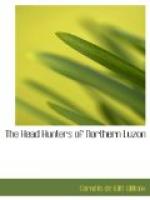The multitude had now begun to disperse, for the sun’s rays were growing level, and the day was over. We were glad ourselves to find our quarters, for we had had some ten hours of gansa-beating, dancing, and all the rest of it: the canao had been a great success, and, although bubud had passed vigorously, the people had made no trouble. We wound up with a little bridge, and there was, as there always is, some business to be dispatched before turning in. But we were all soon sound asleep, for next morning we had to be up at four. [27]
CHAPTER XIV
Barton’s account of a native funeral.
Mr. Barton, already mentioned as in residence at Kiangan as local Superintendent of Schools, went out to see the funeral of the Constabulary private killed on the morning of the 2d. He was strongly advised not to go, because these highlanders resent more or less the presence of strangers at their funeral ceremonies. But this made him only the more eager, as very few Americans, or any others for that matter, have ever been present on these occasions.
Passing through Manila a month or two later, he very kindly dictated for me an account of what he saw, and I give it here, with his permission, in his own words:
The Funeral of Aliguyen.
“On the third day after the soldier was killed, the principal funeral ceremonies took place. To these ceremonies came a great number of people from their various rancherias, the party from each rancheria being led by the relatives of the soldier, some of them very distant relatives.
“Aliguyen, the dead soldier, lived in the rancheria of Nagukaran, a rancheria until quite recently very unfriendly to Kiangan, where I live. Aliguyen, however, had some kin in Kiangan, and this kin, together with their friends, went to the funeral. Their shields, as well as the shields of all who attended, were painted with white markings, taking some the form of men, some of lizards, some were zig-zags. All men who attended had a head-dress made of the leaf petiole of the betel tree and the red leaves of the dongola plant. To these leaves were attached pendant white feathers. Everybody was dressed in his best clout, and the women in their best loin-cloths and in all their finery of gold beads and agate necklaces.




